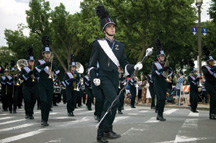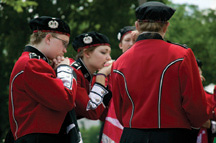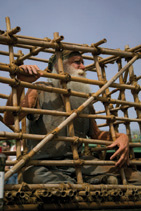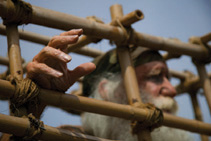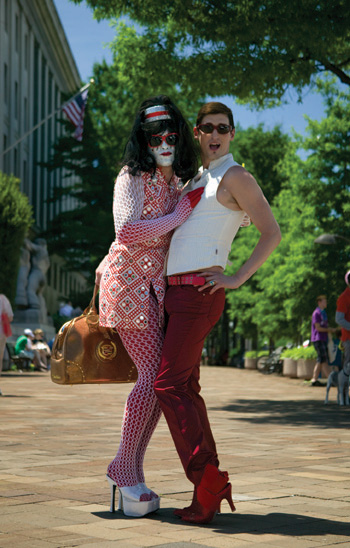
Sirena Sparkle and companion at the Capital Pride Festival.
A full dance card is a common occurrence for a visitor to DC. On any given day or night, the list of happenings is long and varied, and you will be able to pick and choose what type of affair suits you to photograph. From political demonstrations to patriotic parades to cultural festivals and international sporting competitions, there is no dearth of event-oriented photo opportunities here in this country’s capital. Many of these events are annual traditions that attract visitors from across the globe, and it is not unusual to find yourself celebrating with 250,000 other tourists. A selection of some of the most popular and those that offer the most interesting photo opportunities are presented here, with tips on how to bring home photographs you can be proud of.
Arranging your travel itinerary around events that occur in a city other than your own could be a taxing project, but, just as if you were a photo shoot producer, with prudent use of the Internet and a few telephone calls, your schedule should fall easily into place. If you are running on a constricted timeframe, do not depend on the web alone for accurate information. A quick phone conversation to garner the correct starting times for, directions to, and logistics of an event can save a lot of heartache and missed opportunities. But, most importantly, be absolutely sure that your camera bag is packed with all the gear you need and that it is in good working order. Pros (or their assistants!) have learned through experience to check and clean their cameras and accessories thoroughly before embarking on a trip.
As mundane as it sounds, this should become a habit for you, since a complete once-over the night before can ward off a lost photo opportunity the next day.
While shooting at an event, you will more than likely be restricted with regard to your choice of vantage point and may find yourself farther away from your subject than is optimal. Longer focal length lenses are in order here. Unfortunately, the more specialized the equipment becomes, the higher the price tag that accompanies it. For this reason, a camera rental house (such as Penn Camera) is a great boon. You can rent a long telephoto lens or a current on-camera flash for a very small fraction of the retail price, assuring that you will have the proper gear on hand.
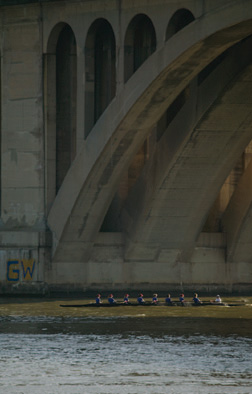
Rowers under the Francis Scott Key Bridge.
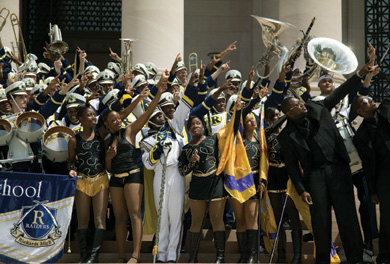
Pointing to Freedom! (Statue atop the Capitol Building.)
This is essential when you are shooting an event where you will have limited access, and the photograph here of a rowing regatta on the Potomac River is a perfect example. The river is long and wide, and you just cannot get close enough to the action with anything but a lens of 300mm or greater. I chose the 300mm in this case, because my aesthetic concern was to show the huge scale of the bridge and how it dwarfed the boat and rowers. Standing on the edge of the river with a shorter lens would yield completely different results.
When exploring and shooting neighborhoods, parks, and scenes, to some extent you are on your own schedule, and aside from the weather and operating hours, you are free to shoot when you desire. You are also at liberty, in most cases, to study your subject matter and take the time to compose and choose the best angle. A parade, demonstration, or sporting event, on the other hand, is a photographic assignment of a completely different animal. When taking photos in situations such as these, you must work within a time-frame—you are restricted not only by start and end times, but, in the instance of a parade or sporting event, by the fleeting moments that your subject is actually within your frame of view. Planning ahead and scouting your location and subjects will greatly increase your chances of capturing beautiful photographs. If it is a parade you are shooting, find out where it begins and plan to be there at about an hour before start time. This gives you plenty of chances to shoot the revelers as they are warming up and to capture the first steps of their promenade unhindered by rows of people. The same goes for sporting and other events—make good use of your time and be bold and adventurous in searching for the best place from which to shoot. You will be glad that you did so when you see the results.
The goals and purpose of the Campaign to End AIDS are outlined on the organization’s website at www.c2ea.org. This brief quote summarizes their work:
The Campaign to End AIDS (C2EA) is a diverse, exciting coalition of people living with HIV & AIDS, their advocates and their loved ones. Together, we’re demanding that our leaders exert the political will to stop the epidemic, in the U.S. and abroad, once and for all. In small towns and big cities across America, we’re mobilizing to ensure the best treatment and care for all HIV-positive people…and HIV prevention methods backed by good science.
The pictures in this section were taken in April of 2009 at a rally organized by the Campaign to End AIDS and its sister organizations, DC Fights Back and NAPWA. Representatives from throughout the U.S. were present, making a graphic stand.
This demonstration was particularly poignant and absolutely rife with powerful and emotionally wrought images. The cross alone is compelling, yet when combined with the black outfit, purposeful stance, and passionate expression, it all makes for a significant photograph. For this shot, I knelt on the sidewalk and shot from a very low angle, both to ensure my background was only blue sky and to “heroicize” my subject matter. The stark contrast of the cross against the sky, the anonymity of the protester, and the color scheme of black, white, and blue all contribute to an image with strong emotional impact. The graphic quality of a shot like this is somewhat reminiscent of Russian propaganda posters. If you look closely, you can see a touch of humor in an otherwise somber presentation—there is a computerized SKU number on the wood used to make the cross.

The C2EA banner.
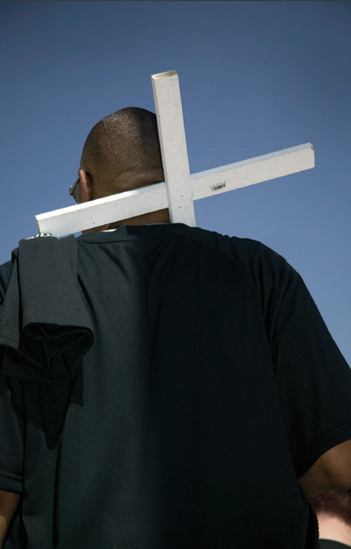
Focal length 95mm; ISO 100; aperture f/5.6; shutter speed 1/250; April 1:57 p.m.

Focal length 56mm; ISO 100; aperture f/5.6; shutter speed 1/250; April 1:56 p.m.
These participants were charismatic to say the least, especially the fellow in the wheelchair with his resigned look and the strong diagonal line of his cane. I saw him from quite a distance and knew immediately that I should hover in his vicinity, as there was most definitely a picture here for me to uncover. I find demonstrators very willing to be photographed, since dissemination of their image only furthers the cause for which they are impassioned. I caught this fellow’s eye as I circled innocently around him and his companions, and when the moment was right, as crosses were raised and the wind lifted their hair, I pressed the shutter. In situations such as these, when someone is essentially “performing,” you will find that if you make eye contact and engage with them in a pleasant manner, your photographs will reflect the energy and empathy of the moment.
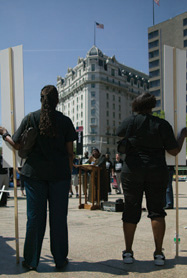
The main speaker and viewers.
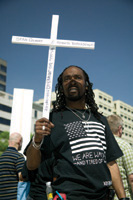
Another C2EA participant.
These shots were taken on the Freedom Plaza at the intersection of 14th Street and Pennsylvania Avenue. This raised area is a popular site for political protests and civic events and is worth visiting, particularly on weekends. The nearest Metro station is Federal Triangle, serviced by the Blue and Orange Lines. Walk north from the station and then left on Pennsylvania Avenue for one block to approach the Plaza.
The Gay Rights movement has fought a lengthy battle to have its voice heard and equal rights granted. Decades of Gay Rights activism and the gradual and uneven transformation of public opinion have brought us to the attitudes of the present day. In Washington, DC in June, on the anniversary of the infamous Stonewall riots that, in 1969, brought Gay Rights to the attention of the public, the Capital Pride Parade and Festival holds its head high in the nation’s capital.
Ten days of Capital Pride events culminate in the Pride Parade, in which more than 130 contingents march, and in the Pride Festival, which features more than 30 bands and acts celebrating the diversity inherent in the gay, lesbian, bisexual, and transgender community. Most recently organized by the Capital Pride Alliance, supported by donors and a 300-person-strong volunteer army, the events attract more than 250,000 visitors. These are events where pictures truly speak for themselves.
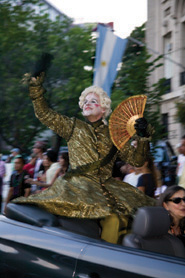
Mozart on parade.
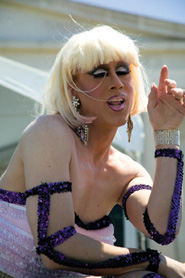
Another performer on the catwalk.
Capital Pride is a veritable and overabundant buffet of photo opportunities. The festival-goers literally clamor over one another to have their likeness immortalized, and these folks seem as if they were born to pose. At the Pride Parade, near Dupont Circle on 17th and P Streets, the main problem is how in the world you focus and choose which photo to take. The parade starts at dusk and ends in the early evening, so out of my gear bag I pulled my 580 EX flash, since the available light would be too low for shooting an event with such wild movement without it. I shot at 1/25th of a second in order to keep the background from going completely black, which it would have if I had synced at the normal 1/60 or 1/125. I headed toward the main viewing stand at 17th and Q, and I parked myself firmly in a spot right on the edge of the street about 30 minutes before the parade was to start. The whistle blew, and the hordes of paraders in various states of dress and undress were off! The color and shape of this fellow’s garb was impossible to resist, and the slow shutter speed gave me some nice movement on the outer edges of the yellow balloons, which adds to the frenetic energy of the scene.
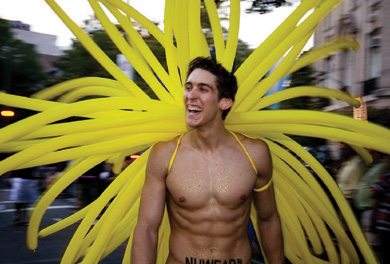
Focal length 47mm; ISO 100; aperture f/4.0; shutter speed 1/25; June 7:19 p.m.
At the Pride Festival on the last Sunday of the festivities, there is a fantastic drag queen and king (yes, king) catwalk, where performances start at about noon and continue on until about 3:00 p.m. Performances is the key word here. The music is thumping, the crowds are wildly appreciative, and the men and women strut their stuff and lip sync with aplomb. I managed to elbow my way right up to the front row, and my view of the performers was blissfully unobstructed. This gal really filled my frame, and my low angle gave me a perfect clear-sky background. The contrast of her rust outfit against the blue is nice and strong, and I love the details of her rhinestone jewelry and black alligator belt.
You will be able to find specific dates for Capital Pride activities on the organization’s website: www.capitalpride.org.
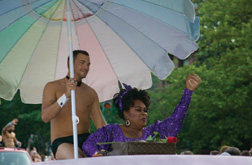
An essay in rainbow and purple—the Pride colors.
The parade route starts at the intersection of 23rd and P Streets. It proceeds along P Street to the Dupont Circle, turns up New Hampshire Avenue, then takes R Street to 17th south, returning to P Street. The final turn takes the parade onto 14th Street, south to the intersection with N Street.
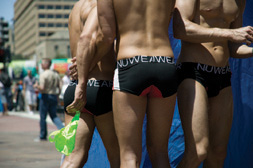
A behind-the-scenes view at the festival.
The festival takes place on a sectioned-off portion of Pennsylvania Avenue around the intersection with 6th Street. The entrance to the festival is located near the Archives Metro Station (Yellow and Green Lines).

Focal length 125mm; ISO 100; aperture f/6.3; shutter speed 1/125; July 1:35 p.m.
As with many tree species, cherry trees are cultivated as a wide variety of types. The most notable division of these cultivars is into the edible and flowering varieties. Whereas the fruit tree industry is responsible for the production of the delicious summer crop of cherries, the flowering cherry tree experts bring us a product more poetic even than the flavor of Grandma’s special cherry pie.
The flowering cherry tree, which produces complex flowers but no fruit, is a native of Asia and has been grown and developed there over many centuries. The Japanese have raised the flowering cherry, the sakura, to an exalted level and celebrate this unofficial national symbol in the annual festival of Hanami. More than 200 different cultivars are grown in Japan. During the January to April period, flowering cherry gardens throughout the country receive multitudes of visitors who schedule their visits to coincide with peak viewing times, much in the same way as Americans follow the emergence of leaf colors with the onset of fall. To the Japanese, the flowering cherry reflects the splendor of life, but also, given the transient nature of the blooms, its fragility. During Hanami, parks and areas around shrines and temples are crowded with families and friends holding flower-viewing parties.
In 1912, Japan made a gift to the United States of 3,000 cherry trees as a token of the emerging friendship between the two nations. Part of the gift was planted in Sakura Park in Manhattan, New York, but the remainder found its way to the water’s banks in West Potomac Park, surrounding the Tidal Basin. The gift was renewed in 1965 with a further 3,800 trees. Americans have embraced the beauty of the trees and the custom of springtime reverence
Standing amidst a grove of cherry trees in full blossom is a sublime experience. So many abstract descriptions come to mind—cherry parfait, flowered clouds, cotton candy, pink pillows, rosy kimonos—it is almost indescribable. The air is filled with falling blossoms, the streets and sidewalks are littered with millions of paper-thin petals, and, most marvelous of all, the light is pink! This is looking through the world with rose-colored glasses at its finest.
The first thing you do is look up, and for this shot, my camera followed my eyes as I looked skyward to the blushing roof above me. I had my camera set on a wide aperture so that the depth of field would be very shallow. I only wanted the central blossoms in my photograph to be sharp, with the rest of them going into soft focus to further the effect of cherry blossom clouds. The sky was a classic azure blue, and the limpid light of spring beautifully backlit the few new leaves. Everything in the photo says fresh, new, and spring.
Note
Take note of the “bloom watch” website (www.nationalcherryblossomfestival.org), which will track and predict to its best efforts the peak bloom time for the cherry trees. This period varies every year but always falls toward the end of March and early April.
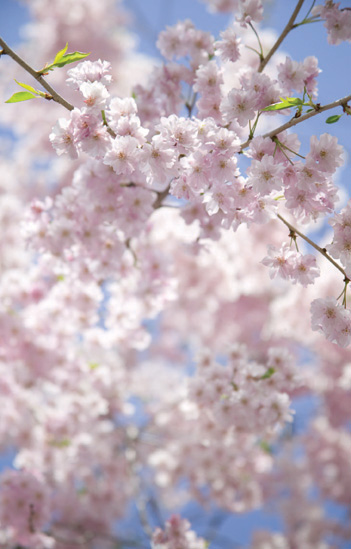
Focal length 135mm; ISO 100; aperture f/5.6; shutter speed 1/250; April 2:31 p.m.
As an artist, I try to find beauty in every situation. The overwhelming impression here, while standing in the Tidal Basin with the cherry trees arching around you, is that you are actually living in a Japanese etching. The drab and monochrome light on this day in particular gave the scene at water’s edge an old, art-world feel. Many photographers would have kept their cameras at home during this weather—the clouds were pregnant with rain, and the ambience was close to gloomy. What this did for me, however, was to strip away any of the romance that would have been translated by pure color and boil the image down to its pure graphic sense. The water is wet and metallic, the branches are arching downward, and there is great tension where they would meet, but the water laps haplessly at the blooms.
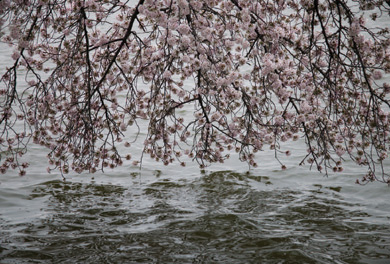
Focal length 85mm; ISO 100; aperture f/5.6; shutter speed 1/80; April 3:32 p.m.
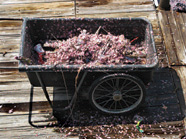
Pink refuse.
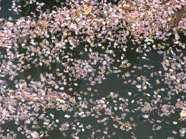
Even the water is wearing petals.
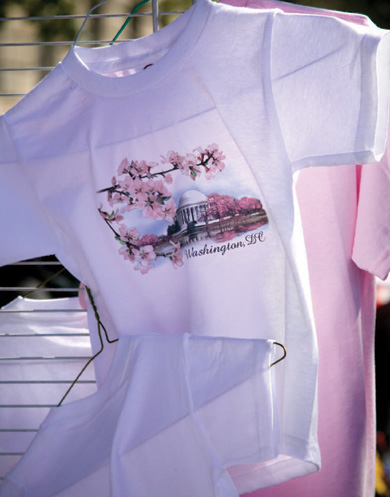
A souvenir.
The Japanese Cherry Tree Garden is located in West Potomac Park, on a small peninsula constituting the southwest bank of the Tidal Basin. It can be reached by walking half a mile southeast from the Lincoln Memorial or by walking a quarter of a mile northwest from the Jefferson Memorial, crossing the bridge where the Basin opens into the Potomac River. For recommended timing to view the blossoms, go to the website of the National Cherry Blossom Festival.
Cherry blossoms are a renowned part of the spring calendar in DC, and Washingtonians don’t let the opportunity pass them by without taking the chance to organize a festival and parade. The festival is brought to a close with fireworks over the Mall, but not before the National Cherry Blossom Festival Parade has worked its way along Constitution Avenue. The parade alone attracts around 100,000 spectators and has a decidedly lighthearted and energetic theme, welcoming in the spring and the promise of a bright year ahead. The parade is a celebration not only of the cherry trees and their pink profusion, but also of the arrival of good weather and the cycle of outdoor activities.
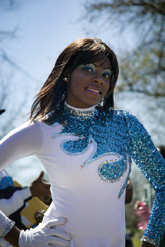
The crowds at this parade are enormous, and if you want to capture any really decent shots, you must plan accordingly. Arrive at the National Mall with enough time to stake your claim right at the edge of Constitution Avenue so that your field of view will not be hampered. Be prepared; every available horizontal surface—sidewalk, step, fire hydrant, lamppost, trash bin, or any protuberance that could possibly be construed as a place to sit—is enveloped with hordes of people trying to secure a better spot from which to witness the musical bands and costumed marchers.

A smart way to get from here to there.
Once the parade gets going, and if the security guards got out of bed on the correct side, you can actually walk quickly along with the parade right at the edge of the street. I think the bigger your camera is, the more you will have a chance to do this!
The sun is not overhead, even at noon, so the hats of these girls are beautifully backlit. The light-gray tarmac acts as a large reflector and bounces some light back up into their faces, filling the dark shadows and reducing the harsh contrast.
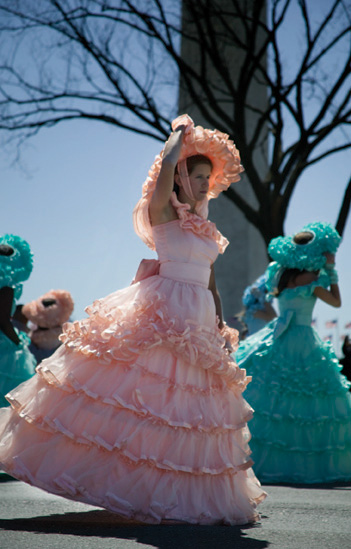
Focal length 109mm; ISO 100; aperture f/5.6; shutter speed 1/1000; April 11:24 a.m.
By all means, do not pack your gear up and go home when the parade is over. Just as the preparations of an event such as this can offer up good photo opportunities, the behind-the-scenes activity can be equally as rewarding. Here, the performers let their hair down, and you can catch some very relaxed yet engaging moments. This tuba player was leaning against the travel bus in a state of quiet repose after having been marching and lugging his instrument for several hours. I approached him as I saw that he was preparing to unload his heavy equipment, and I was taken by his gentle expression and the connection that he so obviously had with his musical instrument. The proximity of the mouthpiece to his face, the gentle touch of his hand near the keys, and the ease with which he maneuvered the weighty piece all spoke of an intimate relationship. The stark black background of the bus perfectly outlines this musician and his beautiful brass tuba.
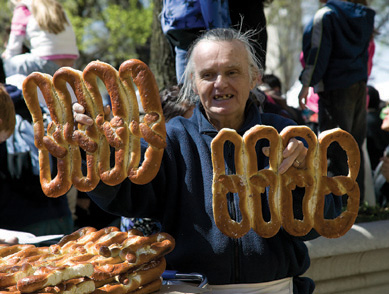
A fixture at every DC parade—the Pretzel Man!
The parade passes along Constitution Avenue NW beginning at 7th Street and ending at 17th Street. The closest Metro stops are Federal Triangle (Orange and Blue Lines) and Archives (Green and Yellow Lines).
Listings, times, and locations of the festival events can be found under the Events tab on the National Cherry Blossom Festival website.

Focal length 135mm; ISO 100; aperture f/5.6; shutter speed 1/1250; April 11:50 a.m.
Since 1777, the adoption of the Declaration of Independence by the Continental Congress has been celebrated on July 4th. From that first year onward, celebrations throughout the nation have included parades, fireworks, and summer festivities. The Washington, DC celebration follows that format but stands out as a national event through its goal of including in the morning parade representatives from every state in the nation. Competition by bands to represent their state in DC can be intense, with a formal procedure of recommendation by the state governor’s office and video auditioning required. The DC parade is a well-choreographed affair featuring military units, floats, bands, giant balloons, notable VIPs, and a liberal sprinkling of patriotic nonconformists. The huge group of spectators along Constitution Avenue is treated to an exhilarating, flag-waving, red, white, and blue national birthday celebration.
The parade leads into a full day of events with the Smithsonian Folklife Festival on the Mall, followed by the evening’s Capitol Fourth Concert, and culminating in a spectacular fireworks display over the Washington Monument.
This shot was taken on the corner of Madison Drive and 7th Street NW, just at the very moment when these women were to start their parading. My on-camera flash, set at one stop below the ambient reading, beautifully enhanced the silky sheen of their scarlet outfits. The alabaster tone of their skin is a stark contrast to the intense red fabric and a perfect complement to the beige tone of the building in the background. The repetition of the red figures makes a strong composition, as does the triangular shape caused by receding perspective.
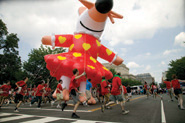
Energetic paraders.
I was drawn to take this photograph for conceptual reasons in addition to structural ones. I could not resist the irony of the American flag neck scarves and fans juxtaposed with the very uniform-like and somewhat militaristic red outfits—a color that is heavy with political overtones. The martial aspect of this photograph is only exaggerated by the intense gaze of the women and their sense of being at the ready. It is just a lucky happenstance that even the very few stragglers who happen to be in this shot are also wearing red!
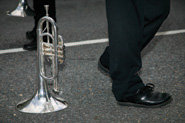
Taking a break.

Focal length 109mm; ISO 100; aperture f/5.6; shutter speed 1/250; July 11:06 a.m.

Waiting to start.
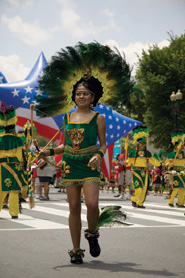
A member of a South American troupe.
This shot also demonstrates an intensity, but of a significantly more playful and civilian genre. These girls are in a dancing troupe that hails from New Jersey, and what you see manifested in their expressions is the earnestness I witnessed in their attempts at mastering their steps. Again, I was shooting at the preparation area of the parade, on Madison Drive and 7th Street NW, with the spectators sparse enough to allow me the proximity and sense of intimacy captured here. The festive and patriotic balloons in the background frame the second girl perfectly, and again, the monochromatic outfits of the subjects lend an elegance to the shot that can sometimes be difficult to achieve in street photography. One must shoot instinctually and with speed to capture moments such as these—learn by repetition to trust your intuition and that gut feeling you have about a potential picture in front of your camera. At sports and public events, you do not have the luxury of time to compose your photographs with precision—you must go with your hunches and shoot quickly.
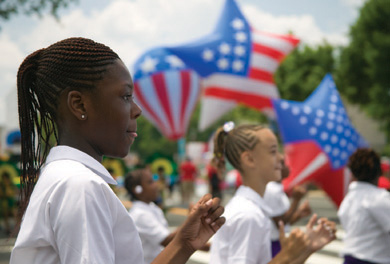
Focal length 90mm; ISO 100; aperture f/5.6; shutter speed 1/320; July 11:48 a.m.
The parade route follows Constitution Avenue from 7th to 17th Streets. The Archives (Yellow and Green Lines) and Federal Triangle (Orange and Blue Lines) Metro stations are less than a block to the north of the route. Arrive early (the parade starts at 11:45 a.m.) to secure a place on the route or to gain access to the setup area on 7th Street as it intersects the Mall.
The governmental organization of the United States was designed around the democratic premise in which the elected representatives of the people would congregate in the nation’s capital and on their behalf develop and pass laws. Wise people were elected to represent, to decide on behalf of the electorate how the country should be run. The electorate could influence their representatives through the ballot box or through discussion when the representative chose to return to his district or state. In the early days of government, distance, poor communication systems, and a simpler approach to life ensured the retention of this approach and a level of independence for the legislators.
Time passed, and people started to recognize that the activities of the world’s most powerful government might not be best left to chance, and that there was an opportunity to be gained by giving them a helping hand in their deliberations. Two groups of people came to the forefront, attracted to Washington to push their agendas or the agendas of their employers into the minds and actions of the legislators: lobbyists and citizen groups. Such influence on behalf of certain groups can be viewed in two ways—either as unfair emphasis of special interest views or as provision of important and useful information to lawmakers.

The policeman’s mount draws some admiration.
Either way, the goal is to influence the lawmakers. While the majority of lobbying activity, carried out by well-remunerated Washington insiders, happens behind firmly closed doors, the work of citizen groups is often found on the streets of the city, attracting attention in a loud, colorful, and—dare I say—photogenic way. Keep your eyes open or scan the Internet to discover the work of some of the many citizens groups visiting the city to influence, protest, or demonstrate. They all have a story to tell, and almost all will be grateful to you and your camera for helping to tell it.
This day and this event were like a gift to me from the photo gods. Conditions for shooting were perfect—clear blue skies, fresh green leaves, dappled light on the subject, bright and saturated colors, fill flash, a sense of humor, and willing subjects with a cause. What more could I have asked for? Oh, yes, and they offered me a bottle of water—did I mention hospitable and generous? As I wrote earlier, protesters and demonstrators are most often extremely willing to have their photograph taken, and the cooperation is welcome. A sense of positive energy exudes when there is a benevolent give and take between photographer and subject. I had my flash set here to fill at one stop below the ambient reading, which makes the bright colors really pop and helps to lighten up dark skin, but at the same time does not come across as too unnatural.
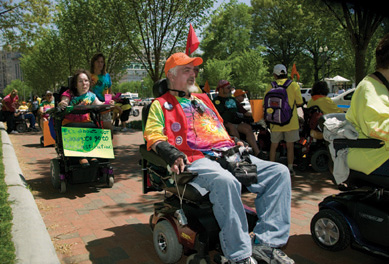
Focal length 41mm; ISO 100; aperture f/5.6; shutter speed 1/250; April 12:46 p.m.
This shot could be described in almost the same words as the previous one, except here we add a much larger dose of humor, portrait-style. This fellow is a leading voice in the DC division of ADAPT, an organization that believes in Community Choice—an act that aims to ensure civil rights for those with disabilities. He was very willing to pose, interact, and share his passion for what he believed in.
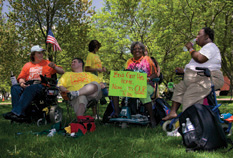
More colorful protestors.
Protesters congregate in the open spaces in DC, depending on the cause to which they are bringing attention. Be alert around the Mall and main government buildings, and do not be shy about using your camera. The protesters themselves will not be shy about being photographed.
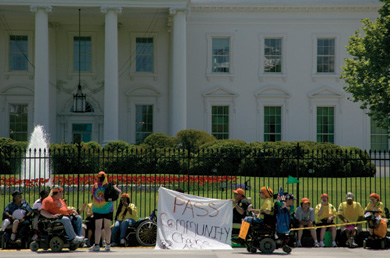
The White House plays host to many demonstrations.
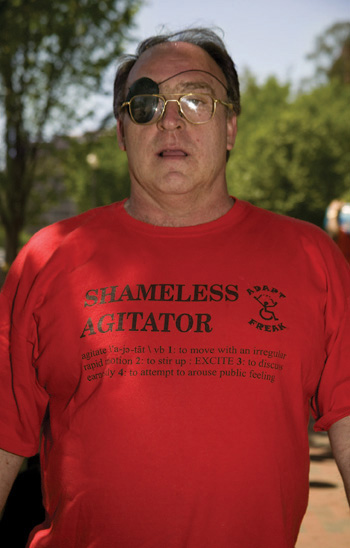
Focal length 80mm; ISO 100; aperture f/5.6; shutter speed 1/250; April 12:40 p.m.
Washington, DC boasts a formidable array of art and architecture, sculptures and monuments, and parades and demonstrations, but there may be no more spectacular sight (and sound) than that of the annual Rolling Thunder Rally.
The motivation behind the Rolling Thunder Rally is to call for the continued recognition and protection by the U.S. government of American prisoners of war (POWs) and individuals missing in action (MIA)—a worthy cause, like many that are championed by visitors to DC. However, the means chosen to publicize the issue are of a type and scale like no other.
At midday on the Sunday of Memorial Day weekend, lead riders leave their congregation area in the vicinity of the Pentagon and forge a path for more than 400,000 motorcycle riders, the majority of whom are military veterans, each riding bikes of spectacular quality. The army of riders proceeds across the Arlington Memorial Bridge, around the Lincoln Memorial, and onto Constitution Avenue. From there they circle the Mall to finally re-congregate on the grass of West Potomac Park.
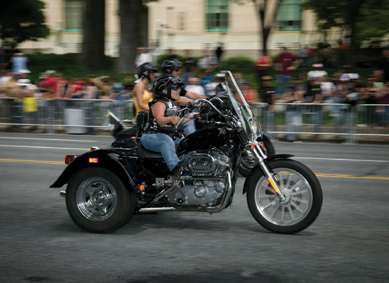
A tricycle and rider.
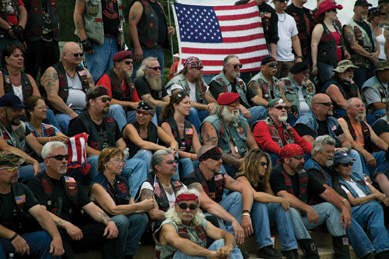
On the steps of the Lincoln Memorial.
The sight of this volume of two-wheeled advocacy is dramatic; the sound is overwhelming and entirely lives up to the name of the event. And finally, take in the sight of the characteristically attired bikers, their vests proudly declaring their allegiance and loyalty and their commitment to the fates of their brother servicemen. You will find the veterans attending events throughout the weekend: the candlelight vigil at the Vietnam Veterans Memorial on Friday evening, the wreath-laying ceremony at the U.S. Navy Memorial on Saturday morning, and the salute to our troops at the Reflecting Pool on Saturday afternoon.
The original Rolling Thunder Rally, named after a 1965 air campaign, was held in 1988 and was attended by 2,500 riders. Since that time, the continuing growth of the rally attests to the ongoing strength of concern for our troops and those making major sacrifices on our behalf. The event organizers have committed to continue the annual rally until all POWs/MIAs are accounted for.
A sea of leather, chrome, and bearded bodies is what it was, and that is just what it looks like in this photograph, taken on the Saturday morning of the Rolling Thunder demonstration. The bikers and their cohorts gather in the Pentagon parking lots, across the river from DC in Arlington, on a first come, first served basis, with as many as 500,000 arriving by midday, when the “rolling” begins. From 5:00 a.m. until noon, you are free to roam and shoot this cooperative and hospitable bunch to your heart’s content. I climbed up to the overpass of Highway 27, stood on a concrete divider, and pointed my camera north. The 300mm lens flattened the perspective of the scene, and I was sure to fill my frame edge to edge with the crowds to properly convey the expanse of the crowd.
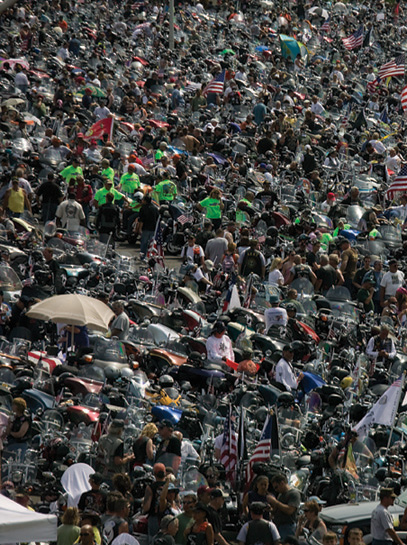
Focal length 300mm; ISO 100; aperture f/11; shutter speed 1/160; May 10:08 a.m.
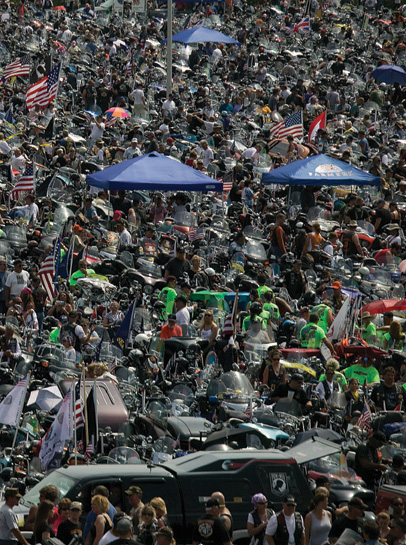
I enjoyed myself tremendously while taking this series of pictures. I sat down literally smack dab in the middle of Independence Avenue SW, which borders the National Mall and is the last stretch that Rolling Thunder moves down before the bikes are parked and the festivities begin. The riders were not going very fast, so it was not as dangerous as it sounds. And, my shooting partner was standing right behind me, arms akimbo, to make us obvious to the drivers. The long telephoto lens proved invaluable again here, because it brought me in so close to my subject, who seemed straight out of Central Casting, and maintained a soft and non-distracting background. The flattened perspective forced the effect that the riders were almost right upon me. I had about 15 minutes of free and entertaining shooting, wondering all along when the security would cut my efforts to a halt. Sure enough, a policeman on horseback vociferously chased us away, but not before I got some really compelling frames.

Focal length 275mm; ISO 100; aperture f/9; shutter speed 1/160; May 12:19 p.m.
Viewing the rally and the bikes in full flow is easiest on Constitution Avenue, north of the Mall, but interesting viewpoints can be found on the Arlington Memorial Bridge or on the west side of the Lincoln Memorial. The congregation area at the Pentagon is reached by crossing the Arlington Memorial Bridge and turning left on the Jefferson Davis Highway. The mass of bikes and riders is readily identifiable in the Pentagon parking lot three quarters of a mile from the bridge.
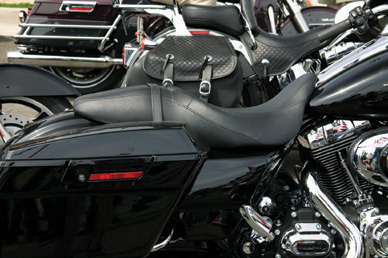
A collage of leather and chrome.

